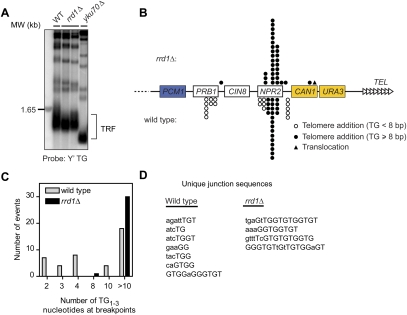Figure 2.
Rrd1 facilitates telomere healing at DSBs with no or short TG1–3 tracts. (A) rrd1Δ cells maintain normal telomere length. The TRFs of the indicated strains were detected by Southern blot with a Y′-TG probe targeting telomere sequences. (B) Schematic representation of the Chr V–L. The breakpoints of the GCR events must land between the essential gene PCM1 (blue) and the selection markers CAN1 and URA3 (yellow). Positions of independent telomere additions or translocations are indicated for wild-type (below) and rrd1Δ (above) strains. (C) Distribution of the number of TG1–3 residues found at the breakpoints of the telomere healing events described in B. (D) Breakpoint junction sites from telomere addition events recovered from wild-type or rrd1Δ strains. The events shown correspond to telomere addition events that occurred outside the NPR2 TG-rich hot spot. Nucleotide sequences are shown as 5′-to-3′ direction, and telomere repeat polymerization began following the last nucleotide indicated. Nucleotides conforming to a TG1–3 sequence are capitalized.

